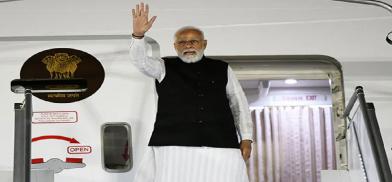Why PM Modi's US visit has rankled China
Thus, China views PM Modi’s visit to the US as a gathering storm for its ambitions to dominate Asia in military, economic and technological spheres. That these are due to China’s recent political and strategic choices is ignored.

China has been watching Prime Minister Narendra Modi’s visit to the United States this week. There are many stakes for China in the emerging US-India strategic partnership. These range from the emerging power distribution at regional and global orders to addressing supply chain and technology disruptions caused by the global financial crisis, Covid-19 pandemic and the current Ukraine conflict.
US National Security Adviser Jake Sullivan stated that US Secretary of State Antony Blinken’s visit to Beijing will not be the “most significant event” for US foreign policy but Modi’s visit to the US will be a “transformational moment”. Blinken’s visit to China proved to be a damp squib. Yan Xuetong, a leading US expert at Tsinghua University, mentioned that little progress can be achieved in relations with the US due to the latter’s guarded “small yard, high fence” policy—which essentially refers to the US restricting hi-tech components' exports to China.
China took notice of Modi’s speech to the US Congress when he mentioned “dark clouds of coercion and confrontation are casting their shadow in the Indo-Pacific” and that “the stability of the region has become the central concerns of our partnership [with the US]”. Clearly, he was critical of China’s recent armed intrusions in the Galwan Valley violating several agreements with India, but also to the massive mobilisation of forces in Taiwan Straits, on Senkaku islands, and the South China Sea. Several countries in the region were affected with the recent Chinese assertiveness.
Officially, China is tight-lipped on Modi's visit to the US, even though during Blinken’s visit to Beijing recently, President Xi Jinping said that China opposes “small cliques”. On the other hand, China’s analysts dish out the narrative ad nauseum on India-US ties being aimed to “contain China”, even while China’s attempted containment of India continues through Pakistan and the Indian Ocean Region.
Shoring up Pakistan
For instance, coinciding with Modi’s visit, China signed an agreement for a 1200 MW nuclear plant with Pakistan valued at $4.8 billion. This is the seventh such plant that China has given to Pakistan. In another development, Central Military Commission vice chairman Zhang Youxi, a childhood associate of Xi Jinping, told visiting Pakistan Chairman of Joint Chief of Staff Sahir Shamshad Mirza that both countries will “work together to meet various global challenges.”
Another bugbear for China is the expansion of American military alliances in Asia. On May 2023, the US House Select Committee on “Strategic Competition between the United States and the Chinese Communist Party” recommended that India be included in the NATO Plus format. However, India’s External Affairs Minister S Jaishankar rejected the idea by saying that the “NATO template doesn't apply to India”.
Even though China has close ties to the “major non-NATO ally” Pakistan which it terms as an “all weather” friend and an “iron brother”, yet it is opposed to India evolving defence ties with the US. In fact, some Chinese analysts argue that closer India-US relations were one of the reasons for China’s aggression in Galwan in June 2020.
Hi-tech transfers a crucial variable
Some Chinese have mentioned that “balancing China” is the main goal of India-US ties. None of course provide evidence in this regard and have been self-centered and self-seeking in their interpretation. Some Chinese analysts also raised human rights issues in India, ignoring the one million incarceration issue in Xinjiang or the “sinicize Buddhism” campaign in Tibet.
Others like Zhao Gancheng of the Shanghai Institute of International Studies moaned that India would become a “US' geopolitical pawn (and) sacrificing India's strategic autonomy and national interests”. Others have gone to the extent of saying that the US wants “to turn India into a war agent of the US”. On the other hand, Chinese argue for balancing and isolating India in the Shanghai Cooperation Organisation (SCO) through the China-Iran-Pakistan trilateral, China-Central Asia summit meetings, China-Pakistan-Afghanistan trilateral and others.
More significantly, China’s analysts identify the May 2022 India-US Initiative on Critical and Emerging Technologies (iCET) mentioned again in the US-India joint statement of June 22, that focus on advanced technologies such as artificial intelligence (AI), semiconductor chips and quantum computing, particularly in the defense sector, as a crucial variable that could influence the strategic environment in Asia for the medium term.
The hi-tech component of the India-US agreements are unnerving to Beijing, also due to the October 2022 US ban of exports of high-performance computing chips to China. In contrast, US Micron is setting up a chip unit in Gujarat worth $825 million, besides a skill training programme by Lam Research. GE-F414jet engines will be produced by HAL in Bengaluru. Thirty-one MQ-9B advanced drones to be supplied to India. A space programme to launch astronauts to the moon has been agreed to with Artemis, while synthetic aperture radar satellite technologies will be shared with India. With Huawei 5G trials removed and US-India open RAN (5G Radio Access Network) implemented, China loses hundreds of billions of dollars of contracts in the Indian market in the telecom sector.
China’s analysts believe that the “US seems to ramp up efforts to push India to confront China and harass China's economic progress”. Some analysts also stated that “Washington's vigorous efforts to strengthen economic and trade cooperation with India is primarily to slow down China's economic development.” However, for India, trade with the US proved to be beneficial. For instance, India-China trade in 2022-23 was $113 billion, while US-India trade shot up to $128 billion in the same period. More significantly, India’s exports to the US increased to over $78 billion, while that to China was $15 billion due to the trade protectionist trends in the China market. That is while India earns much more from trade with the US, the country has lately been losing by way of China trade about $60 billion on an average every year.
Visit a churning point?
Another aspect that is beneficial to India is the investment profile. While US investment in India stood at $54 billion, that of China’s share in India is less than $8 billion. Moreover, the US investments in India are generally in the hi-tech sectors, while China is in the low-tech sector.
China is also concerned with losing supply chains. With the pandemic originating in Wuhan in late 2019, one of the major casualties has been an intensive disruption in the global supply chains that were centered in China. This has led to a drastic decline in growth rates for every country. To mitigate this challenge, India-Japan-Australia initiated the Supply Chain Resilience Initiative by emphasising on digital trade. The US-India joint statement also mentions supply chain restoration plans.
Thus, China views PM Modi’s visit to the US as a gathering storm for its ambitions to dominate Asia in military, economic and technological spheres. That these are due to China’s recent political and strategic choices is ignored. China’s rise, with the help of the US, has created conditions for the country’s recent assertive behaviour. Beijing is not only challenging the US globally, but also major powers in the Asia region.
China is imposing its leadership over Asia, a part of which is to question the independent decision-making powers of India, Vietnam, Indonesia and other countries. The Indian prime minister's visit to the US has come at this churning point in Asia’s destiny.
(The author is an acknowledged China expert and Dean of the School of International Studies, Jawaharlal Nehru University., New Delhi. Views are personal. By special arrangement with The Billion Press)
casino en ligne France
You explained that superbly.
casino en ligne
Kudos, I value this!
casino en ligne France
Valuable info Regards.
meilleur casino en ligne
Regards. A good amount of material.
casino en ligne
You actually expressed this effectively!
casino en ligne fiable
Thank you, A lot of stuff!
casino en ligne
You actually reported it well.
casino en ligne
Cheers! An abundance of advice!
casino en ligne France
Really tons of helpful material!
casino en ligne France










Post a Comment